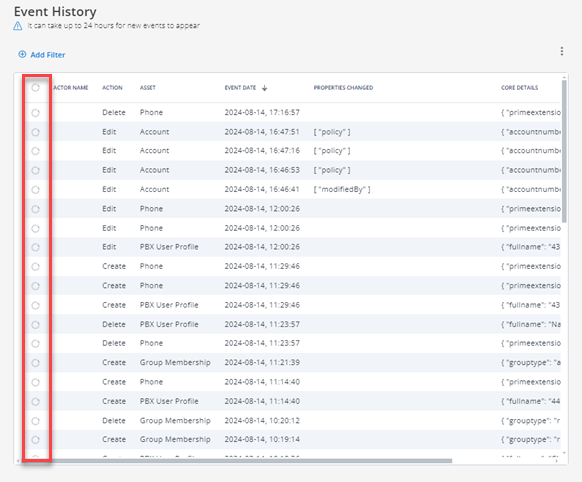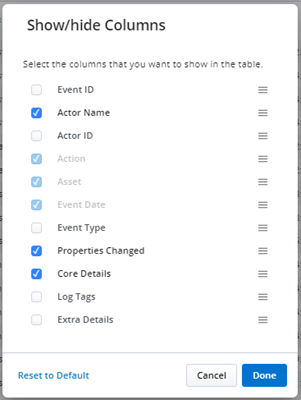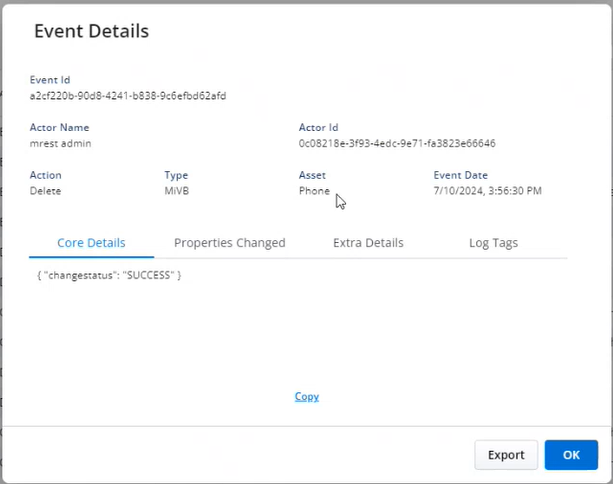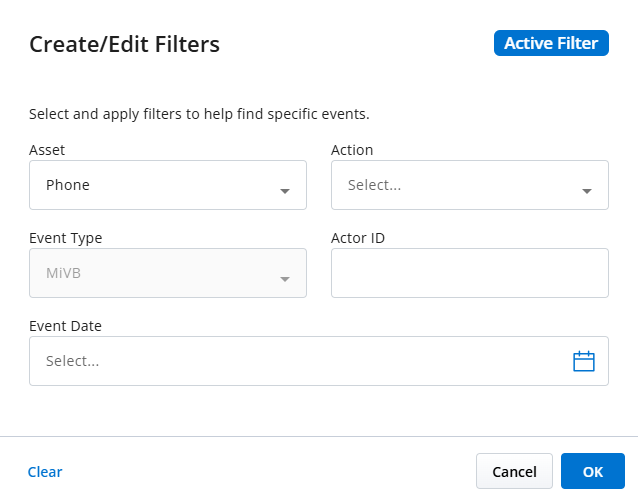Event History
The Event History provides insight to Mitel Partners and Account Admins regarding events that occurred within an account. With filtering and exporting capabilities, this feature allows for targeted analysis of events to help with troubleshooting and change management.
- Accounts with the MiVoice Business integration enabled and the Administration feature toggled ON.
- Accounts with the Zoom integration enabled.
Accessing Event History
To access Event History and view changes, do the following:
-
Log in to the Mitel Administration as a Mitel Partner or Account Administrator.
-
This step is applicable to Mitel Partners only, if you are an Account Administrator, proceed to Step 3. Navigate to Accounts and select the desired account.
-
Navigate to Support > Event History.
It might take around 15 seconds to load the Event History page.
Note:-
Spinners are displayed while retrieving data.
-
It can take up to 24 hours for new events to appear.
 Note:
Note:If an error occurs while retrieving data, the following banner will be displayed. Refresh the page to attempt to reload the data.
 Note:
Note:By scrolling down in the table, more events will be retrieved until all available events are displayed. At that point, the following banner will be displayed

-
Event History table
The Event History table has the following features:
-
The data can be sorted by Event Date by clicking the column header.
-
The columns displayed can be customized:
-
Click the
 icon, select Show/hide columns.
icon, select Show/hide columns. -
In the pop-up, select the checkbox(es) of interest.
-
Rearrange the columns by dragging the
 icon up or down as desired.
icon up or down as desired.
-
Batch Exporting
-
In the event table, select the checkbox(es) of the desired events.
The Export button appears showing the number of events selected.

-
Click Export to export the data of the selected events to a .csv file.
Event Details
The Event History table has the following fields:
| Name | Description |
|---|---|
|
EVENT ID |
The ID of the event. |
|
ACTOR NAME |
The name of the user or entity that triggered the action (for example, User ABC, System, Solution, SCIM, Unknown) 'Unknown' will appear if a name can no longer be found (for example, the user who triggered the event has been deleted) |
|
ACTOR ID |
The CloudLink ID or System ID of the entity that triggered the event. |
|
ACTION |
The event action (for example, Create, Edit, Delete). |
|
EVENT TYPE |
The event type or category (for example, Admin, MiVoice Business, Service Delivery). |
|
ASSET |
The object that was acted upon (for example, Phone, Account, User License). |
|
EVENT DATE |
The date and time the event occurred. |
|
PROPERTIES CHANGED |
A list of properties that changed for the asset during the event. For example, if a phone's macAddress is edited -> ["macAddress"] |
|
CORE DETAILS |
Detailed information about the event. |
|
EXTRA DETAILS |
Extra details about the event, if available. |
|
LOG TAGS |
Special tags are appended to each event to facilitate search functionality. |
After clicking on an event in the Event History table, the Event Details window will be displayed.

The Event Details window has the following features:
-
Copy: to place the selected tab's data on your clipboard.
-
Export: to export all data from all tabs for that event to a .csv file.
Filtering Event Data
To search for particular events, you can add filters to the table by clicking the Add Filter ![]() button. Multiple filters can be applied to significantly narrow down event data.
button. Multiple filters can be applied to significantly narrow down event data.
The available filter options may vary depending on the integrations enabled for a Cloudlink account. For example, accounts with the MiVoice Business integration enabled and the Administration feature toggled ON will have a unique set of filter options compared to accounts with the Zoom integration enabled. While some filter options may overlap, others will be specific to each integration. Accounts with both integrations enabled will have access to a combined set of filter options, providing a superset of both.
|
Filter name |
Options |
Description |
Available with the MiVB integration |
Available with the Zoom integration |
|---|---|---|---|---|
|
Asset |
Account |
The customer account for this CloudLink integration. |
X |
X |
|
DID |
Direct Inward Dialing numbers. |
X |
||
|
DN Range |
Directory Numbers, or extensions, that are reserved for user assignment. |
X |
||
|
Group |
A MiVoice Business system group is based on the following types:
|
X |
||
|
Group Membership |
User's Directory Numbers added to the MiVoice Business system groups. |
X |
||
|
PBX User Profile |
The base description of a user in the PBX, contains information like first name, last name, etc. |
X |
||
|
Phone |
A device that is associated with a user. |
X |
||
|
Templated Services |
UCC applications deployed for the user based on the definitions in the User Templates learned from the solution. |
X |
||
|
User License |
The license assigned to a user on Zoom. |
X |
||
|
Tenant |
The Account ID associated with the customer's Zoom account. |
X |
||
|
Action |
Create |
Events where the asset was created. |
X |
X |
|
Delete |
Events where the asset was deleted. |
X |
X |
|
|
Edit |
Events where the asset was edited. |
X |
X |
|
|
License Assignment |
Events where the asset (such as User License) was assigned. |
X |
||
|
License Configuration Update |
Events where the asset (such as User License) was updated. |
X |
||
|
License Removal |
Events where the asset (such as User License) was removed. |
X |
||
|
Event Type |
Admin |
Events of type Admin are related to the CloudLink configuration. |
X |
|
|
MiVB |
Events of type MiVB are related to Mitel Administration actions for MiVoice Business solutions. |
X |
||
|
Service Delivery |
Events of type Service Delivery are related to Mitel Administration actions specific to the Zoom integration. |
X |
||
|
Actor ID |
Enter the desired Actor ID |
The CloudLink ID or System ID of the entity that triggered the event. |
X |
X |
|
Event Date |
Use the calendar to select a date and time range. You can select:
Custom start and end times can also be specified. |
The date and time range within which the events must have occurred. |
X |
X |
When both integrations are enabled for an account, you can search for events related to a specific integration by selecting filter options that are only available for that integration.
- From the Event Type drop-down list, select Service Delivery
- From the Asset drop-down list, select User License or Tenant
- From the Action drop-down list, select License Assignment, License Configuration Update or License Removal.
The filter feature is a smart filter, therefore the options will change depending on the filters that have already been applied/selected.

After selecting all the desired filter options, click OK. The Event History table will update to show events that match the selected filters.
If no events are found, the following banner is displayed:
 .
.
Editing the active filter
- Click
in the Active Filter Details section.
The Create/Edit Filters page opens.
- Update the desired information.
- Click OK or Apply.
The filter details are updated, and the Event History table refreshes to show events that match the updated filters.
Deleting the active filter
To delete the active filter, click in the Active Filter Details section.
The Event History table refreshes and shows all available events for the account.